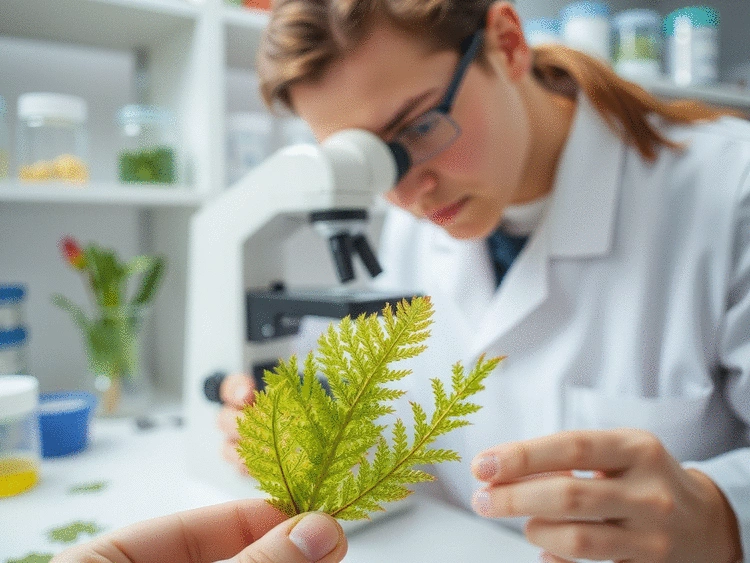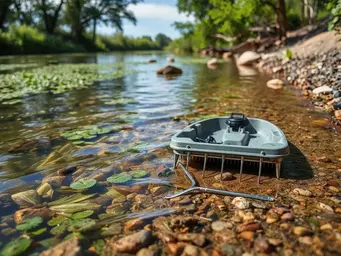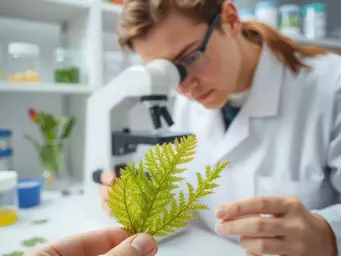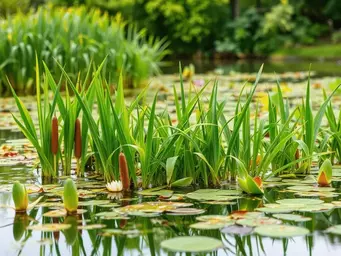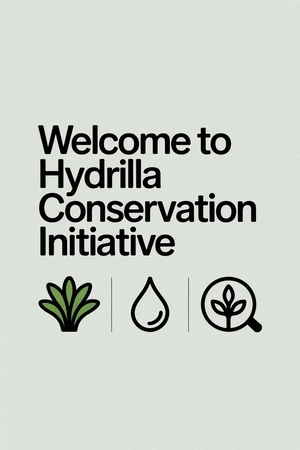Did you know that understanding the genetic variability of hydrilla can significantly improve management strategies for this invasive species? As we explore the complexities of hydrilla, we uncover vital insights that can help protect our aquatic ecosystems.
What You Will Learn
- The two primary strains of hydrilla, monoecious and dioecious, differ in reproductive strategies and adaptability.
- Hydrilla significantly alters habitats, leading to biodiversity loss and navigation issues in waterways.
- Identifying hydrilla involves recognizing key morphological traits, such as whorled and serrated leaves.
- Molecular techniques, including DNA sequencing and isoenzyme analysis, enhance understanding of hydrilla's genetic variability.
- Collaboration among researchers and resource managers is essential for effective hydrilla management.
- Incorporating genetic knowledge into management practices allows for tailored strategies and informed policy decisions.
Hydrilla Strain Differentiation: Morphological vs. Molecular
This visual compares the two primary approaches for identifying and characterizing Hydrilla strains, highlighting their distinct methods and applications.
Morphological Techniques
- 1 Whorled Leaves (5-7 per whorl)
- 2 Serrated Leaf Edges
- 3 Dark Green & Rubbery Texture
- 4 Distinguishing from Elodea (3 leaves)
Initial detection & field identification.
Molecular Techniques
- 1 Isoenzyme Patterns for Biotype
- 2 DNA Sequencing & Genetic Markers
- 3 Genetic Diversity Assessment
- 4 Population Dynamics Insights
Accurate strain identification & management.
Hydrilla Strain Types
- ★ Monoecious Strain
- ★ Dioecious Strain
Different reproductive strategies & resilience.
Management Insights
- ✓ Tailored Strategies (Strain-Specific)
- ✓ Informed Policy Decisions
- ✓ Efficient Resource Allocation
Optimizing efforts against invasive species.
Understanding Genetic Variability in Hydrilla Strains
As we delve into the world of hydrilla, it’s essential to appreciate its genetic variability and the impact it has on aquatic ecosystems. Hydrilla is not just a plant; it’s an intricate part of our waterways that can significantly influence the health of these environments. By understanding its genetics, we can better manage its spread and mitigate its effects on native species.
In my years of studying invasive aquatic plants, I’ve seen firsthand how hydrilla’s adaptability allows it to thrive in a variety of conditions. This adaptability can lead to rapid growth and domination in aquatic ecosystems, often pushing out native flora and fauna. Understanding the genetic underpinnings of hydrilla is critical for those of us dedicated to preserving our aquatic environments!
Defining Hydrilla and Its Importance in Aquatic Ecosystems
Hydrilla verticillata, commonly known as hydrilla, is an invasive aquatic plant that has raised many eyebrows among environmentalists and conservationists alike. It can create dense mats on the water’s surface, which can block sunlight from reaching native plants below. This occurs because hydrilla grows quickly and can spread rapidly, often resulting in ecological imbalance. The U.S. Fish and Wildlife Service provides an ecological risk screening summary for Hydrilla verticillata, highlighting its significant impact.
- Habitat Alteration: Hydrilla can change the physical habitat, affecting water quality and temperature.
- Biodiversity Loss: Its dominance leads to reduced biodiversity as native species struggle to compete.
- Waterway Navigation Issues: Dense growth can impede fishing, boating, and other recreational activities.
By recognizing hydrilla's significance, we can better comprehend why management strategies are crucial. Ultimately, this understanding empowers environmental professionals and educators, including those engaged with the Hydrilla Conservation Initiative, to take proactive measures!
Overview of Hydrilla Strains: Monoecious vs. Dioecious
When it comes to hydrilla, it’s essential to differentiate between the two primary strains: monoecious and dioecious. These strains not only exhibit different reproductive strategies but also vary in their resilience and adaptability to environmental conditions.
- Monoecious Strain: This strain has both male and female reproductive structures on the same plant, enabling it to reproduce quickly in favorable conditions.
- Dioecious Strain: In contrast, dioecious hydrilla requires both male and female plants to reproduce, which can limit its spread under certain conditions.
Understanding these differences is vital for effective management. For instance, the monoecious strain often leads to faster colonization, which can overwhelm local ecosystems. By studying these variations, we can develop targeted strategies to combat hydrilla's spread and protect our native habitats.
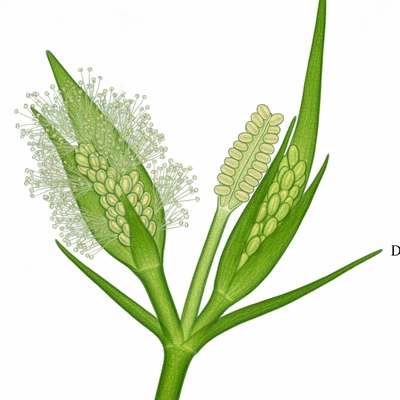
Identifying Hydrilla: Morphological and Molecular Techniques
Correctly identifying hydrilla is the first step in managing its impact on ecosystems. Both morphological characteristics and molecular techniques are valuable in distinguishing hydrilla from other aquatic plants. This knowledge is crucial for environmental professionals, as it helps tailor management strategies effectively.
From my experience, utilizing a combination of these techniques can enhance our understanding and approach to controlling hydrilla populations. Let’s explore some key characteristics and methods to ensure accurate identification!
Key Morphological Characteristics for Identification
To effectively identify hydrilla, it’s essential to recognize its specific morphological traits. This can often be the difference between correctly identifying hydrilla and mistaking it for a similar species. Here are some key characteristics to look for:
- Whorled Leaves: Hydrilla typically has whorled leaves in groups of five to seven.
- Serration Patterns: The edges of the leaves are often serrated, giving them a distinctive appearance.
- Color and Texture: The leaves are usually a dark green and can feel somewhat rubbery to the touch.
Recognizing these traits can significantly aid in early detection and management efforts. The sooner hydrilla is identified, the easier it is to control its spread and minimize its impact on local ecosystems!
Examining Leaf Structure and Serration Patterns
A closer examination of the leaf structure and serration patterns can reveal much about the species in question. The whorled leaves of hydrilla, especially, play a crucial role in its identification. When looking at a sample, observe the leaf arrangement carefully, as it can help distinguish hydrilla from beneficial aquatic plants.
Take note of how the serrations appear on the leaf edges. Hydrilla’s serrated leaves can be a clear indicator, especially when compared to smoother-edged aquatic plants. By paying attention to these details, you can enhance your identification skills significantly!
Distinguishing Hydrilla from Similar Species
Hydrilla can often be mistaken for other aquatic plants, such as Elodea or Cabomba, which is why accurate identification is essential. Key differences include:
- Leaf Whorling: Unlike hydrilla, Elodea has leaves arranged in whorls of three!
- Growth Habit: Cabomba has broader leaves that emerge from the water's surface, unlike the submerged nature of hydrilla.
By understanding these distinctions, environmental professionals can reduce the likelihood of misidentification, leading to more effective management strategies. Purdue University provides a helpful guide on hydrilla identification and its management.
Molecular Techniques for Accurate Strain Identification
While morphological characteristics are essential for identification, molecular techniques provide a deeper understanding of hydrilla strains. These techniques can reveal genetic differences and help in assessing the variability within populations.
For those of us at the Hydrilla Conservation Initiative, implementing these methods can enhance our research efforts and ensure we’re addressing the right strains effectively!
Applying Isoenzyme Patterns for Biotype Differentiation
One effective molecular technique involves analyzing isoenzyme patterns. This method allows us to differentiate between biotypes of hydrilla based on their enzymatic profiles. By comparing these patterns, we can determine which strain is present in a given area, which is crucial for targeted management approaches.
The use of isoenzyme analysis provides valuable insights into the genetic diversity of hydrilla populations, allowing us to make informed decisions regarding control methods!
Using DNA Sequencing and Genetic Markers to Study Genetic Variability
DNA sequencing is another powerful tool in our arsenal for studying hydrilla. By employing genetic markers, we can assess the genetic variability within and between hydrilla populations. This information is vital for understanding how different strains might respond to management strategies. Research published in the Journal of the Botanical Research Institute of Texas details genetic variation among hydrilla populations.
- Genetic Diversity Assessment: Understanding genetic diversity can help predict how hydrilla will adapt to control methods.
- Population Dynamics: Insights into population structure can inform more effective management tactics.
As we continue our work at the Hydrilla Conservation Initiative, these molecular techniques will play a key role in guiding our efforts to manage and mitigate the impacts of hydrilla on our vital ecosystems.
Pro Tip
Did you know? Utilizing a combination of morphological and molecular techniques not only enhances the accuracy of hydrilla identification but also enables more effective management strategies. This integrated approach can significantly improve your ability to respond to hydrilla invasions and protect local ecosystems!
Summarizing Key Findings on Hydrilla Strain Variability
Understanding the genetic variability among hydrilla strains is crucial for effective management strategies. This variability can impact how hydrilla interacts with its environment and responds to control measures. By recognizing the differences in genetic makeup, we can tailor our approaches to tackle this invasive species more efficiently.
Hydrilla's ability to adapt and evolve in various ecosystems poses a significant challenge. As Dr. Clara Thorne, founder of the Hydrilla Conservation Initiative, I have witnessed firsthand how different strains can affect local biodiversity and water quality. This understanding is fundamental in crafting management strategies that are both sustainable and effective.

The Importance of Genetic Understanding in Management Efforts
Incorporating genetic knowledge into management efforts allows us to better predict the behavior of hydrilla in different habitats. Here are some key reasons why this understanding is vital:
- Tailored Management Strategies: Knowing which strain is present helps design specific interventions.
- Informed Policy Decisions: Genetic data supports regulations that protect vulnerable ecosystems.
- Improved Resource Allocation: Efficient use of funds and time can be achieved by targeting the most problematic strains.
As we delve deeper into hydrilla's genetic variability, we can enhance our responses to its spread. This has significant implications for protecting our waterways and preserving native flora and fauna.
Addressing Future Research Directions and Management Implications
Looking ahead, it’s crucial to explore various avenues of research that can deepen our understanding of hydrilla. These directions will not only inform management practices but also contribute to broader ecological knowledge:
- Genetic Mapping: Identifying genetic markers that indicate specific strains.
- Conservation Strategies: Developing plans that focus on preserving native species impacted by hydrilla.
- Adaptive Management Approaches: Continuously updating strategies based on new genetic findings.
As we gather more data, we can adapt our management practices to be more effective against the challenges hydrilla presents. My goal at the Hydrilla Conservation Initiative is to provide resources and support for ongoing research in this area.
Frequently Asked Questions About Hydrilla Management
- Q: What are the two primary strains of hydrilla?
- A: The two primary strains are monoecious and dioecious, which differ in their reproductive strategies and adaptability.
- Q: How does hydrilla impact aquatic ecosystems?
- A: Hydrilla significantly alters habitats, leading to biodiversity loss, blocking sunlight for native plants, and hindering waterway navigation.
- Q: What are the key morphological characteristics used to identify hydrilla?
- A: Key characteristics include whorled leaves (5-7 per whorl), serrated leaf edges, and a dark green, rubbery texture. It can be distinguished from Elodea, which has three leaves per whorl.
- Q: How do molecular techniques help in hydrilla management?
- A: Molecular techniques like isoenzyme analysis and DNA sequencing help accurately identify hydrilla strains, assess genetic diversity, and understand population dynamics, leading to more targeted and effective management strategies.
- Q: Why is collaboration important for effective hydrilla management?
- A: Collaboration between researchers, resource managers, and local communities is essential for sharing knowledge, data, and resources, leading to a unified and more effective approach to controlling invasive hydrilla.
Engaging with the Community: Sharing Knowledge on Hydrilla Management
Encouraging Collaboration Between Researchers and Resource Managers
Collaboration is essential in the fight against hydrilla. By fostering partnerships between researchers and resource managers, we can create a more unified approach to managing this invasive species. Here are some ways to enhance collaboration:
- Workshops and Training: Hosting events to share knowledge and techniques for effective hydrilla management.
- Data Sharing Platforms: Creating systems for sharing genetic and ecological data among professionals.
- Community Engagement: Involving local communities in monitoring and reporting hydrilla presence.
These collaborative efforts can lead to stronger outcomes in our battle against hydrilla, ensuring that we pool our resources and expertise effectively.
Inviting Reader Participation: Your Experience with Hydrilla Control
Your experiences matter! I invite you to share your own stories and insights on hydrilla control. Have you tried any specific management strategies? What challenges have you faced? Your feedback can help build a robust community dedicated to tackling invasive species.
At the Hydrilla Conservation Initiative, we believe in the power of shared knowledge. Together, we can develop better strategies and support one another in our mission to protect our precious aquatic ecosystems!
Recap of Key Points
Here is a quick recap of the important points discussed in the article:
- Genetic Variability: Understanding hydrilla's genetic variability is crucial for effective management strategies against its spread.
- Strain Differences: Distinguishing between monoecious and dioecious strains helps in tailoring management approaches.
- Morphological Identification: Key morphological traits like whorled leaves and serration patterns are essential for accurate identification.
- Molecular Techniques: Utilizing molecular techniques such as DNA sequencing enhances our understanding of hydrilla strains and their genetic diversity.
- Community Engagement: Collaboration among researchers, resource managers, and local communities is vital for effective hydrilla management.
